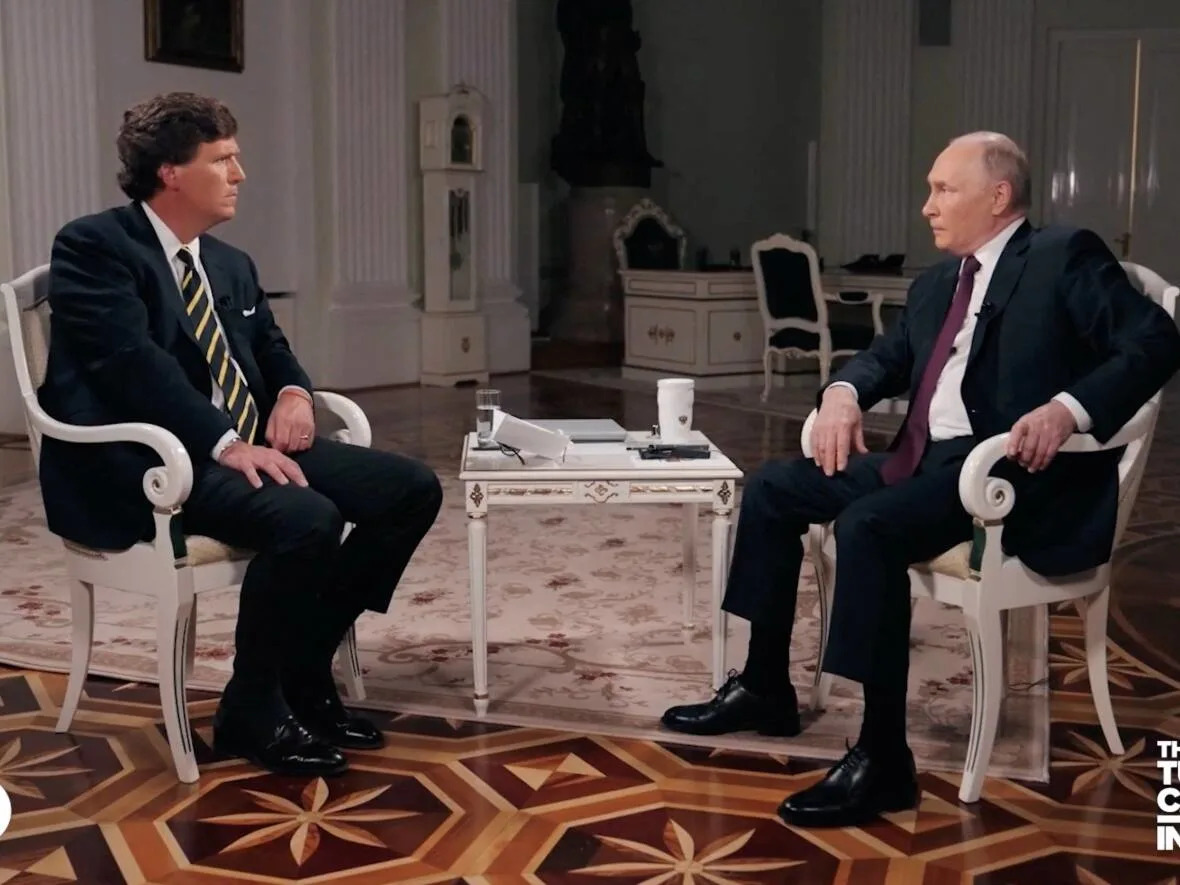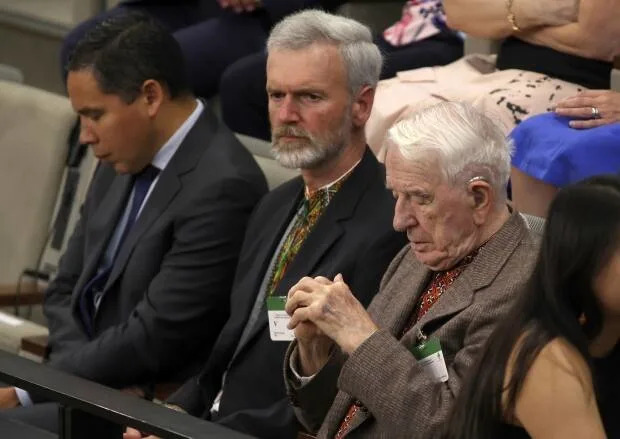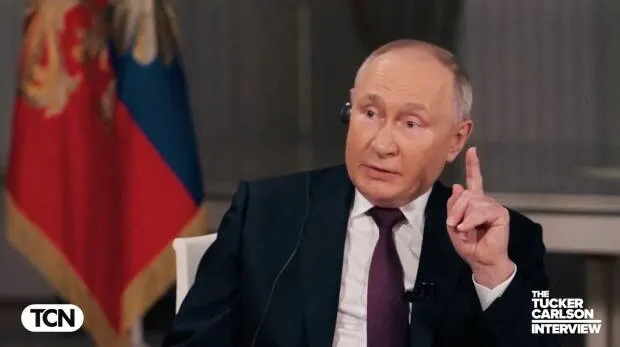CBC
Thu, February 8, 2024

Russian President Vladimir Putin spoke with U.S. media personality Tucker Carlson in an interview conducted in Moscow on Tuesday and released on his Tucker Carlson Network website Thursday evening. (Tucker Carlson Network/Reuters - image credit)
Russian President Vladimir Putin used an interview with U.S. media personality Tucker Carlson to take a shot at Ukrainian President Volodymyr Zelenskyy for joining in a standing ovation for a veteran of a Second World War Nazi unit during his visit to Canada.
Zelenskyy gave an address to Parliament during the September visit. He was introduced by Prime Minister Justin Trudeau and thanked by then-Speaker of the House Anthony Rota.
During his remarks, Rota recognized a man from his riding, Yaroslav Hunka, and praised the Ukrainian Canadian for fighting the Russians during the Second World War. Zelenskyy, Trudeau and the rest of the House rose to applaud Hunka.
Media reports later revealed that Hunka fought with the Waffen-SS Galicia Division, also known as the SS 14th Waffen Division and sometimes the First Ukrainian Division. The unit was made up of Ukrainian volunteers from Galicia and was under Nazi command.

Patrick Doyle/The Canadian Press
"The president of Ukraine stood up with the entire Parliament of Canada and applauded this man. How can this be imagined?" Putin told Carlson through a translator. Carlson posted the interview on X, formerly Twitter.
While historians say men joined the unit for a variety of reasons — including a desire to fight for Ukrainian independence from the Soviet Union — the incident was a major diplomatic embarrassment for Canada.
Putin has repeatedly claimed he is waging war on Ukraine in order to "de-Nazify" the country and has jumped on the Hunka affair to justify his argument in the past.
Western allies, including Canada, have consistently pushed back against those claims, calling Russia's full-scale invasion a blatant violation of Ukraine's sovereignty.
During the interview, Putin suggested that the Hunka affair is "being silenced in Western countries," despite extensive media coverage of the incident last fall.
The Russian president has greatly limited his contact with international media since he launched the full-scale war in Ukraine in February 2022.
Western journalists were invited to Putin's annual press conference in December — the first since the war began — but only two were given the chance to ask a question.
Putin's spokesperson, Dmitry Peskov, told reporters that Carlson was chosen for the interview because "he has a position which differs" from other English-language media.
Before his exit from Fox News, Carlson repeatedly questioned the validity of U.S. support for Ukraine following the Russian invasion and speculated about why Americans are told to hate Putin so much. His commentaries were frequently circulated on Russian state-run media.

Tucker Carlson Network/Reuters
Carlson's trip comes as he aligns himself with former U.S. president Donald Trump in a growing split in the Republican party over Putin and the Ukraine war. Trump has pushed to cut off aid to Ukraine, and the GOP majority controlling the House of Representatives has so far complied.
The U.S. has sent Ukraine more than $110 billion US in aid since Russia invaded in February 2022.
Putin's stance on wider war in Europe
Putin, speaking in Russian with his words dubbed into English, made lengthy remarks about Russia's relations with Ukraine, Poland and other countries during the interview, which was more than two hours long.
He said he had no interest in expanding its war in Ukraine to other countries such as Poland and Latvia.
Asked if he could imagine a scenario in which he would send Russian troops to Poland, a NATO member. Putin replied: "Only in one case, if Poland attacks Russia. Why? Because we have no interest in Poland, Latvia or anywhere else. Why would we do that? We simply don't have any interest."
Putin, who will be seeking a fifth term as president in this year's election, said Western leaders had come to realize it was impossible inflict a strategic defeat on Russia and were wondering what to do next.
"We are ready for this dialogue," he said.
Putin devoted a substantial part of the interview to complaining that Ukraine had been on the verge of agreeing a deal to end hostilities at talks in Istanbul in April 2022, but backed away, he said, once Russian troops withdrew from near Kyiv.
| Vladimir Putin says Russia will intensify attacks on Ukaine:
"Well now let them think how to reverse the situation," he said. "We're not against it. It would be funny if it were not so sad … this endless mobilization in Ukraine, the hysteria, the domestic problems, sooner or later it will result in an agreement."
The Russian leader said the U.S. had pressing domestic issues to worry about.
"Wouldn't it be better to negotiate with Russia? Make an agreement. Already understanding the situation that is developing today, realizing that Russia will fight for its interests to the end," Putin said.
Washington has made clear it has no interest in talking on Putin's terms.
U.S. journalist's release possible
Putin told Carlson that it might be possible to free Wall Street Journal reporter Evan Gershkovich, who is awaiting trial on spying charges, in exchange for a Russian prisoner.
He said Russian and American special services were discussing the case and had made some progress.
The Russian president suggested that in return, Moscow wanted Germany to free Vadim Krasikov, who was convicted of the 2019 murder of a Chechen dissident in Berlin.
Gershkovich was arrested on March 29, 2023 in the Urals city of Yekaterinburg and accused of trying to obtain defence secrets. He and his newspaper strongly reject the charges and the U.S. government has designated him as wrongfully detained.

Evgenia Novozhenina/Reuters
Russia and the United States have agreed high-profile prisoner swaps in the past — most recently in December 2022, when Moscow traded Brittney Griner, a U.S. basketball star convicted of a drugs offence in Russia, for Russian arms trafficker Viktor Bout.
Putin, without mentioning Krasikov by name, referred to a person who "due to patriotic sentiments, eliminated a bandit in one of the European capitals."
Last month a Moscow court extended Gershkovich's custody by two months. Putin said the reporter had been "caught red handed when he was secretly getting confidential information."
Tom Porter
Updated Fri, February 9, 2024
The former Fox News host Tucker Carlson interviewed Russian President Vladimir Putin.
Putin most likely chose Carlson because of his ignorance of Russia and its history.
Putin steamrolled Carlson with two hours of dubious history that he used to justify war on Ukraine.
Tucker Carlson claimed to be venturing into territory no other Western journalist had dared in interviewing Russian President Vladimir Putin.
The Kremlin itself had hyped Carlson's credentials, saying he was the only Western journalist granted permission to talk to Putin in two years because his position was "in clear contrast to the position of the traditional Anglo-Saxon media."
But when the interview was released on Thursday, another likely reason Putin chose the former Fox News host for the two-hour interview became clear.
For much of it, Carlson sat in silence as Putin expounded his dubious historical theories about Ukraine, aired his grievances, and pushed MAGA talking points designed to appeal to Carlson's core audience.
"This is a stage for Big Vlad to showboat," Ian Garner, an expert on Russian propaganda, wrote on X as Putin seized control of the interview.
Putin has used these theories to justify his brutal invasion of Ukraine, where, according to the UN Human Rights Council, Russia has used mass killings, rape, and torture in an attempt to subjugate the country. Putin even published an essay on the theories just ahead of the invasion.
It matters because Putin is seeking to erode support for Ukraine among the GOP voters who form Carlson's core audience as congressional Republicans continue to block a $66 billion Ukraine aid bill.
Carlson seemed to lack the knowledge or willingness to offer even the most cursory pushback. He can perhaps be forgiven for appearing bemused when Putin started lecturing him on obscure historical figures, such as Rurik of Novgorod, but offered no challenge even as Putin discussed more recent events.
For instance, he allowed Putin to claim that the 2014 Maidan protests, in which Ukrainians took to the streets to demand freedom from Russian control, were a CIA plot. There's no evidence of this.
He also allowed Putin to claim, unchallenged, that Russia sought peace with Ukraine before launching the 2022 invasion. There's no evidence of this, with Russia illegally seizing swaths of Ukraine in 2014 and stoking conflict in the east of the country.
Putin was also able to claim, unchallenged, that the invasion was a bid to "de-Nazify" the country and not the campaign of revanchist conquest it is in reality.
Putin was given a two-hour platform to further undermine Republican support for Ukraine and offer an alternative version of history in which the US and NATO were the true aggressors.
Carlson will probably see a huge boost in his audience from the interview. Since his ouster from Fox News in 2023, he's been reduced to interviewing fringe figures such as an online conspiracy theorist who goes by the name "Catturd."
But in increasing his own profile, he's allowed Putin to present his alternative and vastly destructive historical theories to a whole new audience.
In response to earlier allegations that he was a pawn of Putin, Carlson told Axios in 2022: "I could care less."
"It's too stupid," he added. "I don't speak Russian. I've never been to Russia. I'm not that interested in Russia. All I care about is the fortunes of the United States because I have four children who live here."
That ignorance of Russia may be coming back to haunt him.
BBC
Thu, February 8, 2024

Tucker Carlson speaks during 2022 FOX Nation Patriot Awards at Hard Rock Live at Seminole Hard Rock Hotel & Casino Hollywood on November 17, 2022 in Hollywood, Florid
American journalist Tucker Carlson is the first Western journalist to interview Russian President Vladimir Putin since his country's invasion of Ukraine in February 2022. The televised sit-down will air on Thursday, bringing a fresh wave of attention to Mr Carlson, once one of the highest-rated hosts in US network news and now an industry outsider.
During his nightly broadcast on Fox News, he had run through a number of segments, all with his signature right-wing bent.
He lambasted President Joe Biden's plans to address racial biases in housing, attacked Mr Biden's son, Hunter, and mocked a commonly used acronym for gay, lesbian and transgender people.
At the end, he gave a cheery sign-off.
"We'll be back on Monday," he said. "In the meantime, have the best weekend with the ones that you love, and we'll see you then."
But Mr Carlson never returned.
That next Monday, the Rupert Murdoch-controlled Fox announced the network and its most popular personality had agreed to "part ways". Tucker Carlson Tonight was no longer.
For six years, the hour-long prime-time programme had ruled the conservative airways, consistently drawing about three million viewers each evening.
And for Mr Carlson, now 54, the show had marked the peak of a career decades in the making.
The Californian - son of an artist and a roving journalist - had first entered the media world in the 1990s, writing for several prominent publications, including New York Magazine, Esquire and The New Republic.
In 2010, with his former university roommate Neil Patel, he founded the conservative news website The Daily Caller, seen as an alternative to left-leaning websites like Huffington Post. The site promised to emphasise original reporting over punditry, but was criticised for publishing unproven allegations against Democratic politicians and promoting racist and sexist stereotypes.
Mr Carlson cut ties with the site in 2020.

Mr Carlson pictured in the office of the Daily Caller, the conservative site he launched in 2010
As he grew his influence online, Mr Carlson also made a foray into broadcast. He worked as a commentator for CNN in the early 2000s before joining MSNBC to host a nightly programme.
It was here that Mr Carlson sharpened his conservative stances, growing increasingly critical of immigration - which he sometimes called an "invasion" - and becoming a voice for the Republican party's nativist wing.
After moving to Fox in 2009, Mr Carlson bounced around the network's minor leagues, including a 2013 stint as weekend co-host of its morning show, where he once fell asleep on air.
By 2016, he was ready for prime-time, launching Tucker Carlson Tonight just a few days after Donald Trump was elected president.
The debut episode attracted nearly four million viewers. But the host caught an even bigger break the next year, when Fox News fired Bill O'Reilly, its most popular host at the time.
Now there was an opening for the next network star, and Mr Carlson promptly took it.
With Mr Trump in the White House, he rode the wave of populist outrage that fuelled the Republican's political victory. His popularity ballooned, and his programme frequently set the agenda for conservatives and, by extension, the Republican party.
As he became appointment viewing for the political right, Mr Carlson also drew fire from fact-checkers and activists, who accused him of pushing racist and nationalist talking points, including the so-called "great replacement" conspiracy theory which claims a cabal of people is plotting to change the demographics of Western countries.
In one episode, he advocated for the US invasion of Canada. In another, he called the metric system the "yoke of tyranny".
And on several occasions, he used his perch at Fox to defend Russia's President Putin.
His controversial statements did not go unnoticed by Fox, who saw several large companies pull advertisements in protest. But for the most part, the network left him to his own devices.

With Donald Trump in the White House, Mr Carlson's popularity ballooned
Then, in April of last year, Mr Carlson's run at Fox came to a sudden end.
The network gave no formal reason for his dismissal, but Mr Carlson's departure was just days after Fox News paid an extraordinary $787m (£633m) settlement to Dominion Voting Systems over false election claims. The lawsuit revealed, among other things, that Mr Carlson derided Mr Trump's election fraud claims in private messages while backing them publicly on the air.
After a few weeks of quiet, Mr Carlson announced he would begin a new show on social media platform X, formerly Twitter.
"Facts have been withheld on purpose along with proportion and perspective. You are being manipulated," he said in the announcement.
That December saw the birth of a paid streaming service, the Tucker Carlson Network, which Mr Carlson framed as free from corporate influence.
His content and guests have become increasingly fringe.
In July, he published a two-and-a-half hour interview with Andrew Tate, the British-American influencer accused in Romania of rape, human trafficking and forming an organised crime group to sexually exploit women.
He also posted a surprise Christmas Eve fireside chat with disgraced actor Kevin Spacey, as he reprised his role as House of Cards lead character, the fictional President Frank Underwood.
Largely, Mr Carlson has failed to re-create the popularity and attention he enjoyed at Fox. Mr Putin's appearance promises be a boon for him, and possibly a way for his star to rise again.
With reporting from Kayla Epstein & Madeline Halpert













